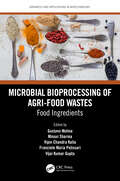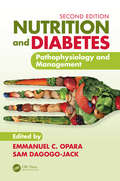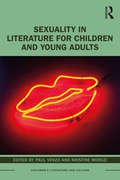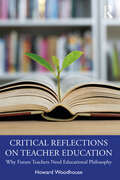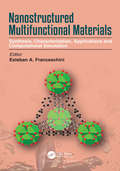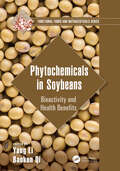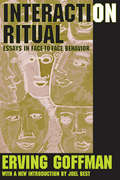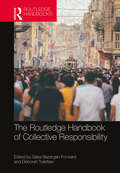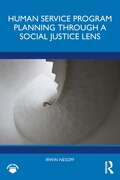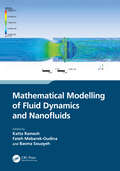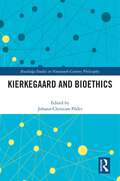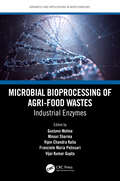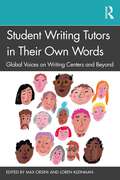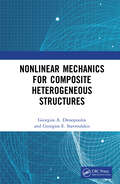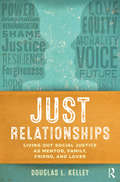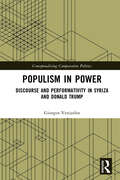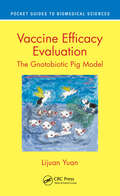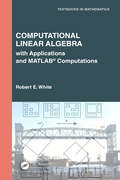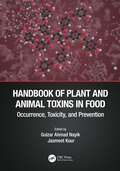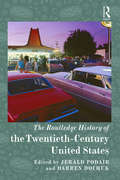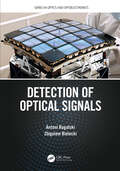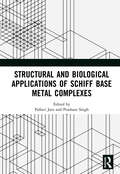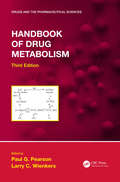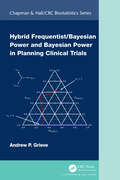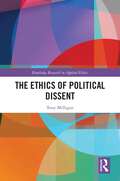- Table View
- List View
Microbial Bioprocessing of Agri-food Wastes: Food Ingredients (Advances and Applications in Biotechnology)
by Gustavo Molina Minaxi Sharma Vipin Chandra Kalia Franciele Maria Pelissari Vijai Kumar GuptaFood ingredients are important molecules of the most diverse chemical classes responsible for conferring nutrition, stability, color, flavor, rheological and sensorial characteristics, in addition to several other important uses in the food industry. In this way, the production routes of these ingredients have gained more and more attention from consumers and producing industries, who expect that, in addition to their technological properties, these ingredients are still obtained without synthetic means, with savings of natural resources and mainly with less environmental impact. This book is intended for bioengineers, biologists, biochemists, biotechnologists, microbiologists, food technologists, enzymologists, and related professionals/ researchers. • Explores recent advances in the valorization of agri-food waste into food ingredients • Provides technical concepts on the production of various food ingredients of commercial interest• Explores novel technologically advanced strategies for the extraction of bioactive compounds from food wastes• Presents important classes of food ingredients obtained from alternative raw materials• Presents sustainable food waste resources and management strategies• Presents different pretreatment technologies and green extraction methodologies to support a green environment in the circular economy concept.• Challenges in applications of re-derived bioactive compounds from food wastes in food formulations
Nutrition and Diabetes: Pathophysiology and Management
by Emmanuel C. Opara and Sam Dagogo-JackDiabetes occurs at such an alarming rate that it can be described as a global epidemic. Following its predecessor, Nutrition and Diabetes: Pathophysiology and Management, Second Edition, is a comprehensive resource that describes various factors that drive the accumulation of excess body weight and fat resulting in obesity. The book discusses the metabolic aberrations found in obesity and how they lead to the association of obesity with diabetes. This new edition highlights the role played by diet and the interrelationships in the metabolism of key nutrients in the pathogenesis of obesity and diabetes which provides the scientific basis for treatment and management approaches.Features Highlights the role of nutrition in the pathogenesis of obesity and diabetes Organized logically into two easy-to-use sections - Pathophysiology and Management of Obesity and Pathophysiology and Treatment of Diabetes Features emerging therapeutic approaches for management of obesity and diabetes Discusses experience in the management of obesity and diabetes in developing countries Presents challenges in insulin therapy and provides guidelines to overcome them The first section of the book retains key topics from the previous edition and contains new chapters including genetic determinants of nutrient processing; fat distribution and diabetes mellitus; combined effect of diet and physical activity in the management of obesity; pharmacologic treatment of obesity; and the role of gut microbiota in the pathogenesis and treatment of obesity. The second section features updated versions of most of the other chapters in the first edition comprising a modified chapter on oxidative stress and the effects of dietary supplements on glycemic control in Type 2 diabetes. In addition, new chapters are added in this section and include the contribution of iron and transition metal micronutrients to diabetes; role of microbiota in the pathogenesis and treatment of diabetes; primary prevention of Type 2 diabetes; and the pathophysiology and management of Type 1 diabetes.
Sexuality in Literature for Children and Young Adults (Children's Literature and Culture)
by Paul VenzoExpanding outward from previous scholarship on gender, queerness, and heteronormativity in children’s literature, this book offers fresh insights into representations of sex and sexuality in texts for young people. In this collection, new and established scholars examine how fiction and non-fiction writing, picture books, film and television and graphic novels position young people in relation to ideologies around sexuality, sexual identity, and embodiment. This book questions how such texts communicate a sense of what is possible, impossible, taboo, or encouraged in terms of being sexual and sexual being. Each chapter is motivated by a set of important questions: How are representations of sex and sexuality depicted in texts for young people? How do these representations affect and shape the kinds of sexualities offered as models to young readers? And to what extent is sexual diversity acknowledged and represented across different narrative and aesthetic modes? This work brings together a diverse range of conceptual and theoretical approaches that are framed by the idea of sexual becoming: the manner in which texts for young people invite their readers to assess and potentially adopt ways of thinking and being in terms of sex and sexuality.
Critical Reflections on Teacher Education: Why Future Teachers Need Educational Philosophy
by Howard WoodhouseCritical Reflections on Teacher Education argues that educational philosophy can improve the quality of teacher education programs in Canada, the United States, and the United Kingdom. The book documents the ways in which the market model of education propagated by governments and outside agencies hastens the decline of philosophy of education and turns teachers into technicians in hierarchical school systems. A grounding in educational philosophy, however, enables future teachers to make informed and qualified judgements defining their professional lives. In a clear and accessible style, Howard Woodhouse uses a combination of reasoned argument and narrative to show that educational philosophy, together with Indigenous knowledge systems, forms the basis of a climate change education capable of educating future teachers and their students about the central issue of our time.
Nanostructured Multifunctional Materials: Synthesis, Characterization, Applications and Computational Simulation
by Esteban A. FranceschiniThe development of nanomaterials plays a fundamental role in current and future technology applications, particularly nanomaterials that have multiple functionalities. This book provides a broad overview of the effect of nanostructuring in the multifunctionality of different widely studied nanomaterials. This book is divided into four sections constituting a road map that groups materials sharing certain types of nanostructuring, including nanoporous, nanoparticled, 2D laminar nanomaterials, and computational methods for characterizations of nanostructures. This structured approach in nanomaterials research will serve as a valuable reference material for chemists, (bio)engineers, physicists, nanotechnologists, undergraduates, and professors.
Phytochemicals in Soybeans: Bioactivity and Health Benefits (Functional Foods and Nutraceuticals)
by Yang Li and Baokun QiSoybeans represent an excellent source of high-quality protein with a low content in saturated fat. They can be made into various foods, such as tofu, miso, breakfast cereals, energy bars, and soy cakes. Much research has been carried out on the positive health effects of soybeans, and increasing evidence shows that consumption of soybeans may reduce the risk of osteoporosis, have a beneficial role in chronic renal disease, lower plasma cholesterol, and decrease the risk of coronary heart disease.Phytochemicals in Soybeans: Bioactivity and Health Benefits describes in detail the chemical characteristics of health-promoting components of soybeans and soybean products, their impacts on human health, and emerging technologies about soybean processing and new products. With 22 chapters containing the most recent information associated with soybean products, topics of the chapters include soybeans’ role in human nutrition and health, their composition and physicochemical properties, action mechanism of their physiologic function, processing engineering technology, food safety, and quality control. Key Features: Promotes soybean products as functional food with advanced processing technology Presents the basic research containing the experimental design, methods used, and a detailed description of the results. Provides a systematic approach to the subject to facilitate a better comprehension of the subjects with illustrations and diagrams Includes a comprehensive and up-to-date list of references With contributions from authors around the world who are experts in their field, this book contains new information on the health impacts of soybean consumption, new product development, and alternative technologies of soybean processing, and will be useful for professors and researchers, as well as graduate and undergraduate students alike.
Interaction Ritual: Essays in Face-to-Face Behavior
by Erving Goffman"Not then, men and their moments. Rather, moment and their men," writes Erving Goffman in the introduction to his groundbreaking 1967 Interaction Ritual, a study of face-to-face interaction in natural settings, that class of events which occurs during co-presence and by virtue of co-presence. The ultimate behavioral materials are the glances, gestures, positionings, and verbal statements that people continuously feed into situations, whether intended or not.A sociology of occasions is here advocated. Social organization is the central theme, but what is organized is the co-mingling of persons and the temporary interactional enterprises that can arise therefrom. A normatively stabilized structure is at issue, a "social gathering," but this is a shifting entity, necessarily evanescent, created by arrivals and killed by departures. The major section of the book is the essay "Where the Action Is," drawing on Goffman's last major ethnographic project observation of Nevada casinos.Tom Burns says of Goffman's work "The eleven books form a singularly compact body of writing. All his published work was devoted to topics and themes which were closely connected, and the methodology, angles of approach and of course style of writing remained characteristically his own throughout. Interaction Ritual in particular is an interesting account of daily social interaction viewed with a new perspective for the logic of our behavior in such ordinary circumstances as entering a crowded elevator or bus." In his new introduction, Joel Best considers Goffman's work in toto and places Interaction Ritual in that total context as one of Goffman's pivotal works: "His subject matter was unique. In sharp contrast to the natural tendency of many scholars to tackle big, important topics, Goffman was a minimalist, working on a small scale, and concentrating on the most mundane, ordinary social contacts, on everyday life.'"
The Routledge Handbook of Collective Responsibility (Routledge Handbooks in Philosophy)
by Bazargan-Forward, Saba / Tollefsen, DeborahThe Routledge Handbook of Collective Responsibility comprehensively addresses questions about who is responsible and how blame or praise should be attributed when human agents act together. Such questions include: Do individuals share responsibility for the outcome or are individuals responsible only for their contribution to the act? Are individuals responsible for actions done by their group even when they don’t contribute to the outcome? Can a corporation or institution be held morally responsible apart from the responsibility of its members? The Handbook’s 35 chapters—all appearing here for the first time and written by an international team of experts—are organized into four parts:Part I: Foundations of Collective ResponsibilityPart II: Theoretical Issues in Collective ResponsibilityPart III: Domains of Collective ResponsibilityPart IV: Applied Issues in Collective ResponsibilityEach part begins with a short introduction that provides an overview of issues and debates within that area and a brief summary of its chapters. In addition, a comprehensive index allows readers to better navigate the entirety of the volume’s contents. The result is the first major work in the field that serves as an instructional aid for those in advanced undergraduate courses and graduate seminars, as well as a reference for scholars interested in learning more about collective responsibility.
Human Service Program Planning Through a Social Justice Lens
by Irwin NesoffHuman Service Program Planning Through a Social Justice Lens provides a foundation in social justice to students while developing practical skills and knowledge about the steps and tasks involved in planning social programs.Through the "parallel process" of contextualizing social issues while teaching the process of program planning, students will develop a perspective on the need for social justice planning and its impact on marginalized communities and populations. The textbook explores current concepts and approaches to understanding social issues and involving impacted communities and individuals. These include: Intersectionality, Appreciative Inquiry, Participatory Planning and Visioning, which serve to challenge preconceptions while coupling these with the step-by-step approach to planning using the Logic Model.Utilizing meaningful examples to demonstrate how social justice planning can be implemented, Human Service Program Planning Through a Social Justice Lens is appropriate for students of social work as well as practitioners in human services, public administration and public health.
Mathematical Modelling of Fluid Dynamics and Nanofluids
by Katta Ramesh Fateh Mebarek-Oudina Basma SouayehMathematical Modelling of Fluid Dynamics and Nanofluids serves as a comprehensive resource for various aspects of fluid dynamics simulations, nanofluid preparation, and numerical techniques.The book examines the practical implications and real-world applications of various concepts, including nanofluids, magnetohydrodynamics, heat and mass transfer, and radiation. By encompassing these diverse domains, it offers readers a broad perspective on the interconnectedness of these fields.The primary audience for this book includes researchers and graduate students who possess a keen interest in interdisciplinary studies within the realms of fluid dynamics, nanofluids, and biofluids. Its content caters to those who wish to deepen their knowledge and tackle complex problems at the intersection of these disciplines.
Kierkegaard and Bioethics (Routledge Studies in Nineteenth-Century Philosophy)
by Johann-Christian PõderThis book explores Kierkegaard’s significance for bioethics and discusses how Kierkegaard’s existential thinking can enrich and advance current bioethical debates.A bioethics inspired by Kierkegaard is not focused primarily on ethical codes, principles, or cases, but on the existential 'how' of our medical situation. Such a perspective focuses on the formative ethical experiences that an individual can have in relation to oneself and others when dealing with medical decisions, interventions, and information. The chapters in this volume explore questions like: What happens when medicine and bioethics meet Kierkegaard? How might Kierkegaard’s writings and thoughts contribute to contemporary issues in medicine? Do we need an existential turn in bioethics? They offer theoretical reflections on how Kierkegaard’s existential thinking might contribute to bioethics and apply Kierkegaardian concepts to debates on health and disease, predictive medicine and enhancement, mental illness and trauma, COVID-19, and gender identity.Kierkegaard and Bioethics will be of interest to scholars and advanced students working on Kierkegaard, bioethics, moral philosophy, existential ethics, religious ethics, and the medical humanities.
Microbial Bioprocessing of Agri-food Wastes: Industrial Enzymes (Advances and Applications in Biotechnology)
by Gustavo Molina Minaxi Sharma Vipin Chandra Kalia Franciele Maria Pelissari Vijai Kumar GuptaEnzymes are biological molecules of great relevance. In addition to the fundamental role in metabolic reactions, they have diverse applications in industrial processes in generating products of great commercial utility for the most diverse areas. Thus, industries seek to expand research to select microorganisms capable of producing enzymes according to their commercial objectives. Considering the diversity of the microbiota kingdom, as well as the diversity of mode of action of different classes of enzymes, this is an area that deserves constant investments to elucidate new applications, considering that these biological catalysts have great selectivity and a diversity of mode of action, reusable, and operate under mild process conditions, becoming the bridge for the development of sustainable processes and for adding value to commercial products. This book is intended for bioengineers, biologists, biochemists, biotechnologists, microbiologists, food technologists, enzymologists, and related professionals/ researchers.• Explores recent advances in the valorization of agri-food waste into enzymes • Explores the main technological advances in the recovery of residues and their use for the production of enzymes• Provides technical concepts on the production of various enzymes of commercial interest • Presents the main classes of enzymes obtained from alternative raw materials.
Student Writing Tutors in Their Own Words: Global Voices on Writing Centers and Beyond
by Max OrsiniStudent Writing Tutors in Their Own Words collects personal narratives from writing tutors around the world, providing tutors, faculty, and writing center professionals with a diverse and experience-based understanding of the writing support process.Filling a major gap in the research on writing center theory, first-year writing pedagogy, and higher education academic support resources, this book provides narrative evidence of students' own experiences with learning assistance discourse communities. It features a variety of voices that address how academic support resources such as writing centers have served as the nucleus for students' (i.e., both tutors and their clients) sense of community and self, ultimately providing a space for freedom of discourse and expression. It includes narratives from writing tutors supporting students in unconventional spaces such as prisons, tutors offering support in war-torn countries, and students in international centers facing challenges of distance learning, access, and language barriers. The essays in this collection reveal pedagogical takeaways and insights about both student and tutor collaborative experiences in writing center spaces.These essays are a valuable resource for student writing tutors and anyone involved with them, including composition instructors and scholars, writing center professionals, and any faculty or administrators involved with academic support programs.
Nonlinear Mechanics for Composite Heterogeneous Structures
by Georgios A. Drosopoulos Georgios E. StavroulakisNonlinear Mechanics for Composite Heterogeneous Structures applies both classical and multi-scale finite element analysis to the non-linear, failure response of composite structures. These traditional and modern computational approaches are holistically presented, providing insight into a range of non-linear structural analysis problems. The classical methods include geometric and material non-linearity, plasticity, damage and contact mechanics. The cutting-edge formulations include cohesive zone models, the Extended Finite Element Method (XFEM), multi-scale computational homogenization, localization of damage, neural networks and data-driven techniques. This presentation is simple but efficient, enabling the reader to understand, select and apply appropriate methods through programming code or commercial finite element software. The book is suitable for undergraduate studies as a final year textbook and for MSc and PhD studies in structural, mechanical, aerospace engineering and material science, among others. Professionals in these fields will also be strongly benefited. An accompanying website provides MATLAB codes for two-dimensional finite element problems with contact, multi-scale (FE2) and non-linear XFEM analysis, data-driven and machine learning simulations.
Just Relationships: Living Out Social Justice as Mentor, Family, Friend, and Lover
by Douglas L. KelleyBringing a social justice lens to daily interpersonal relationships, Just Relationships offers a perspective on existing social science theory that demonstrates how our personal relationships should be grounded in fairness and justice. Douglas Kelley utilizes concepts from a variety of academic disciplines and helping professions to examine the barriers encountered in achieving balanced partnerships. This student-friendly book brings the important new perspective of social justice to courses focusing on interpersonal relationships and family relationships, supplementing traditional textbooks. This book presents key relationship theories in each chapter and then applies them from a social justice perspective; uses thought-provoking case studies and guiding questions to enhance student learning; examines a number of different types of interpersonal relationships including family, friends, lovers, and mentor-mentee relationships within a variety of socioeconomic and sociocultural contexts.
Populism in Power: Discourse and Performativity in SYRIZA and Donald Trump (Conceptualising Comparative Politics)
by Giorgos VenizelosShifting attention away from policy achievements and effects on democracy, this book focuses on the charismatic function of populist discourse – comprising antagonistic narratives, transgressive style and appeals to the common people.The book puts forward an integrative approach that brings together discourse analysis, analysis of digital media, in-depth interviews and ethnographic methods, and places into comparative perspective the cases of SYRIZA in Greece and Donald Trump in the United States. Theorising populism through the lens of collective identification, Venizelos places the rhetorical and emotional dynamics of populist performativity at the core of the analysis, offering a rigorous yet flexible conceptulisation of populism in power. Against theoretical expectations, findings suggest that both SYRIZA and Trump retained, to different degrees, their populist character in power, although their style and vision differed vastly.This book urges researchers, journalists and politicians to adopt a reflexive approach to analysing the political implications of populism for politics, polity and society, and to challenge the normatively charged definitions that are uncritically reproduced in the public sphere. It will appeal to researchers of political theory, populism, comparative politics, sociologists and ethnographers.
Vaccine Efficacy Evaluation: The Gnotobiotic Pig Model (Pocket Guides to Biomedical Sciences)
by Lijuan YuanTesting the immunogenicity, protective efficacy and safety in animal models is a crucial step in vaccine development. Pigs raised in germ-free environments, called gnotobiotic (Gn) pigs, are one of the most useful animal models for testing vaccines. The Gn pig model is a widely accepted model for studying pathogenesis and immunity and an ideal model for pre-clinical testing for the safety and efficacy of enteric viral vaccines. Through these studies and others, the Gn pig model has been established as the most reliable animal model for pre-clinical evaluation of human rotavirus and norovirus vaccines. This book provides detailed information on establishing Gn pig models, determining a proper virus inoculum pool and challenge dose, measuring protection and calculating efficacy, and delineating intestinal and systemic immune responses associated with the protection.Key Features Provides a natural history of human rotavirus and norovirus infection in Gn pigs Establishes the optimal virus challenge doses in Gn pigs for vaccine evaluation Evaluates various candidate rotavirus and norovirus vaccines Discusses human gut microbiota transplanted Gn pig models Documents the role of probiotics and rice bran as prophylactics and vaccine adjuvants
Computational Linear Algebra: with Applications and MATLAB® Computations (Textbooks in Mathematics)
by Robert E. WhiteCourses on linear algebra and numerical analysis need each other. Often NA courses have some linear algebra topics, and LA courses mention some topics from numerical analysis/scientific computing. This text merges these two areas into one introductory undergraduate course. It assumes students have had multivariable calculus. A second goal of this text is to demonstrate the intimate relationship of linear algebra to applications/computations.A rigorous presentation has been maintained. A third reason for writing this text is to present, in the first half of the course, the very important topic on singular value decomposition, SVD. This is done by first restricting consideration to real matrices and vector spaces. The general inner product vector spaces are considered starting in the middle of the text.The text has a number of applications. These are to motivate the student to study the linear algebra topics. Also, the text has a number of computations. MATLAB® is used, but one could modify these codes to other programming languages. These are either to simplify some linear algebra computation, or to model a particular application.
Handbook of Plant and Animal Toxins in Food: Occurrence, Toxicity, and Prevention
by Gulzar Ahmad Nayik and Jasmeet KourThe prevalence of naturally occurring toxins in plant and animal foods represents one of the most significant food safety issues, drawing the attention of both scientists and regulators alike. This unexplored area related to food quality is indeed a big concern for consumers, various regulatory authorities, and food industries. Apart from essential nutrients, several food crops are capable of producing a vast array of nonnutritious secondary metabolic products. These toxins produced as secondary metabolites have the potential to exhibit both beneficial and deleterious effects in both human beings and animals. Nevertheless, there has been huge progress in agricultural practices and food processing technologies, but still the number of nonnutritive substances and naturally derived toxins persist in our diet. Handbook of Plant and Animal Toxins in Food: Occurrence, Toxicity, and Prevention, focuses on various selected toxins in foods derived from plants as well as animals. The prominent plant toxins include solanine and chaconine, mushroom toxins, phytates, tannins, oxalates, goitrogens, gossypol, phytohemagglutinins, erucic acid, saponins, cyanogenic glycosides, enzyme inhibitors, BOAA (lathyrogens), toxic amino acids and toxic fatty acids. The prominent animal toxins covered in the book include various seafood toxins, shellfish toxins and biogenic amines. Key Features: Presents complete information about a plethora of toxins Provides quick and easy access to data on major plant and animal toxins Covers distribution of toxins in the plant and animal kingdom Provides comprehensive information on chemistry, safety and precautions of each toxin Commencing with a brief introduction of food toxins, this book is designed in such a way that the readers will be introduced to toxicity, safety and occurrence of each toxin selected. It also discusses the in-depth detailed information on food poisoning and its prevention. The book will also shed light on foodborne illness associated with toxins. The primary audience for this work will be food scientists, food toxicologists, university scholars and college students. Furthermore, the book will be of immense help for public health officials, pharmacologists, and food safety officers who are involved with enforcing regulations meant to ensure the safety of a particular food
The Routledge History of Twentieth-Century United States (Routledge Histories)
by Jerald Podair Darren DochukThe Routledge History of the Twentieth-Century United States is a comprehensive introduction to the most important trends and developments in the study of modern United States history. Driven by interdisciplinary scholarship, the thirty-four original chapters underscore the vast range of identities, perspectives and tensions that contributed to the growth and contested meanings of the United States in the twentieth century. The chronological and topical breadth of the collection highlights critical political and economic developments of the century while also drawing attention to relatively recent areas of research, including borderlands, technology and disability studies. Dynamic and flexible in its possible applications, The Routledge History of the Twentieth-Century United States offers an exciting new resource for the study of modern American history.
Detection of Optical Signals (Series in Optics and Optoelectronics)
by Antoni Rogalski Zbigniew BieleckiDetection of Optical Signals provides a comprehensive overview of important technologies for photon detection, from the X-ray through ultraviolet, visible, infrared to far-infrared spectral regions. It uniquely combines perspectives from many disciplines, particularly within physics and electronics, which are necessary to have a complete understanding of optical receivers.This interdisciplinary textbook aims to: Guide readers into more detailed and technical treatments of readout optical signals Give a broad overview of optical signal detection including terahertz region and two-dimensional material Help readers further their studies by offering chapter-end problems and recommended reading. This is an invaluable resource for graduate students in physics and engineering, as well as a helpful refresher for those already working with aerospace sensors and systems, remote sensing, thermal imaging, military imaging, optical telecommunications, infrared spectroscopy, and light detection.
Structural and Biological Applications of Schiff Base Metal Complexes
by Pallavi Jain Prashant SinghCoordination compounds have been well-known for their wide variety of applications for over a century, as well as enhancing the researcher’s interest and concern in evaluating their action mechanism. It is certainly one of the most intensely discussed research topics. Coordination compounds involve different metal-ion-ligand phenomenon. The involved metal ions play a significant role in structural association and functioning of several processes in the genetic and metabolism system. In recent years, Schiff base ligands have gained significant interest and received a keen interest of many researchers. Schiff’s base ligands have been recognized to hold a wide variety of biological and medicinal activities due to the presence of donor atoms. They have proved exceptional pharmalogical actions such as antimicrobial, anti-tuberclosis, antiplatelet, antidiabetic, antiarthritis, antioxidant, anti-inflammatory, anticancer, antiviral, antimalarial, and analgesic. These biologically active Schiff base ligands have also been shown to inhibit enzyme mobilization and, when bound to a metal ion, exhibit enhanced biological activity, making them useful in a number of fields. As a result, metal complexes of Schiff base ligands are gaining popularity due to their unique properties and functionalities. Schiff base complex-based research for educational and industrial purposes is booming, and the number of publications is gradually increasing. Despite these interests, there is currently no detailed book on Schiff base metal complexes that covers the structures, biological activities, and other non-biological perspectives.This book delves into the structures of Schiff base metal complexes, which are critical in assessing the biological viability of any complex. It also highlights their biological significance in pharma and drug discovery like antibacterial, antifungal, anticancer, anti-inflammatory, anti-arthritis, anti-diabetic, antioxidants, anti-proliferative, antitumor, anticancer, antiviral. The fundamentals of metal complexes are described, as well as an up-to-date outline of developments in synthesis, characterization methods, properties- chemical, thermal, optical, structural, and applications. This book also discusses the other applications of Schiff base metal complexes: as sensor (luminescent, electrochemical, and biosensor), as pigments in dying and paint industries, as photocatalyst to improve the degradation rate.Features : This book would be useful for academia, researchers and engineers working in the area of Schiff base and their metal complexes. This book will give an in-depth account of the properties of Schiff base and their metal complexes. This book will discuss the details of synthesis methods for Schiff base and their metal complexes. This book will cover emerging trends in the use of Schiff base metal complexes in the industry. This book will provide an overview of the wider biological applications of Schiff base metal complexes
Handbook of Drug Metabolism, Third Edition (ISSN #Vol. 186)
by Paul G. Pearson and Larry C. WienkersThis book continues to be the definitive reference on drug metabolism with an emphasis on new scientific and regulatory developments. It has been updated based on developments that have occurred in the last 5 years, with new chapters on large molecules disposition, stereo-selectivity in drug metabolism, drug transporters and metabolic activation of drugs. Some chapters have been prepared by new authors who have emerged as subject area experts in the decade that has passed since publication of the first edition.
Hybrid Frequentist/Bayesian Power and Bayesian Power in Planning Clinical Trials (Chapman & Hall/CRC Biostatistics Series)
by Andrew P. GrieveHybrid Frequentist/Bayesian Power and Bayesian Power in Planning Clinical Trials provides a practical introduction to unconditional approaches to planning randomised clinical trials, particularly aimed at drug development in the pharmaceutical industry. This book is aimed at providing guidance to practitioners in using average power, assurance and related concepts. This book brings together recent research and sets them in a consistent framework and provides a fresh insight into how such methods can be used.Features: A focus on normal theory linking average power, expected power, predictive power, assurance, conditional Bayesian power and Bayesian power. Extensions of the concepts to binomial, and time-to-event outcomes and non-inferiority trials An investigation into the upper bound on average power, assurance and Bayesian power based on the prior probability of a positive treatment effect Application of assurance to a series of trials in a development program and an introduction of the assurance of an individual trial conditional on the positive outcome of an earlier trial in the program, or to the successful outcome of an interim analysis Prior distribution of power and sample size Extension of the basic approach to proof-of-concept trials with dual success criteria Investigation of the connection between conditional and predictive power at an interim analysis and power and assurance Introduction of the idea of surety in sample sizing of clinical trials based on the width of the confidence intervals for the treatment effect, and an unconditional version.
The Ethics of Political Dissent (Routledge Research in Applied Ethics)
by Tony MilliganA broadly liberal politics requires political compassion, not simply in the sense of compassion for the victims of injustice but also for opponents confronted through political protest and (more broadly) dissent. There are times when, out of a sense of compassion, a just cause should not be pressed.There are times when we need to accommodate the dreadfulness of loss for opponents, even when the cause for which they fight is unjust. We may also have to come to terms with the irreversibility of historic injustice and reconcile. Political compassion of this sort carries risks. Pushed too far, it may weaken our commitment to justice through too great a sympathy for those on the other side. It would be convenient if such compassion could be constrained by a clear set of political principles. But principles run the quite different risk of promoting an ‘ossified dissent,’ unable to respond to change.In this book, Tony Milligan argues that principles are only a limited guide to dissent in unique, contingent circumstances. They will not tell us how to deal with the truly difficult cases such as the following: Should the Lakota celebrate Thanksgiving? When is the crossing of a picket line justified? What kind of toleration must animal rights advocates cultivate to make progress within a broadly liberal political domain? And how should we respond to the entangling of aspiration towards social justice with anger and prejudice (such as the ‘anti-Zionist’ discourse)? We may be tempted to answer these questions by presupposing that alignment (the business of choosing sides) is ultimately more important than compassion, but sometimes political compassion trumps alignment. Sometimes, being on the right side is not the most important thing.
